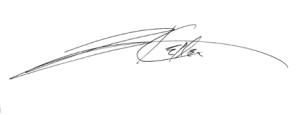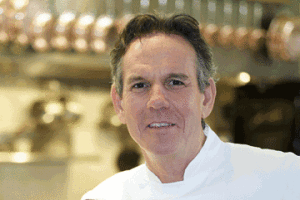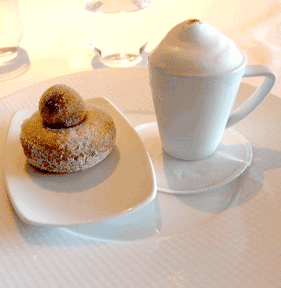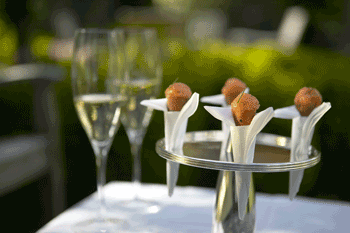TOM KELLER:
AMERICA’S SUPER CHEF

New York City, November 5, 2007.
The youngest of five boys, Thomas Keller was born on October 14, 1955 at Camp Pendelton in Oceanside, California to Edward, a Marine drill instructor, and Betty Keller, a restaurant manager. Four years after his parents divorced, the family moved to Palm Beach, Florida.
During his teenage summers Keller worked at the Palm Beach Yacht Club, where he discovered his passion for cooking, and at the Dunes Club in Rhode Island under the guidance of the French-born chef Roland Henin. Later Henin recommended him to the owners of a small French restaurant called “La Rive” in the Catskills. After three years, when his attempt to buy “La Rive” failed, Keller took off for New York City and Paris where he apprenticed in several Michelin-starred restaurants.
Keller returned to the States in 1984 and with a partner in 1987 opened “Rakal,” a favorite with Wall Street yuppies. Its refined and very expensive French cuisine won him a two-star review in The New York Times, but its success waned when the stock market bottomed out. The next few years were bleak ones for Keller, but he never lost hope.
His search for his dream restaurant came true in 1994 when he opened “The French Laundry” in Yountville, California, in the Napa Valley. Since then: in 1998 he opened “Bouchon” just down the street; in 2004 an outpost of “Bouchon” in The Venetian in Las Vegas; in 2006 “Per Se” in the Time Warner Complex at Columbus Circle in New York and “ad hoc” in Yountville. He also owns two “Bouchon” bakeries, one in Yountville and the other downstairs from “Per Se.”
Besides cooking and running his restaurants, Keller is the author of two cookbooks: The French Laundry and Bouchon, as well as the designer of a white Limoges porcelain dinnerware by Reynaud called Point after the the great chef Fernand Point and of a collection of silverware for Christofle.
Among his awards too numerous to list: in 2005 three stars in the inaugural Michelin Guide to New York for “Per Se” and in 2006 another three stars in the inaugural Michelin Guide to the Bay Area for “The French Laundry.” After a roundtable discussion held at the 92nd Street Y in New York, he met with Lucy Gordan.

Chef Thomas Keller
LG: Our tastes in food are closely connected to our childhood; your first memories of food?
TK: I don’t really have many early memories of food. Being a single parent, my mother didn’t cook often at home. Peanut butter was certainly one of my favorite foods and still is.
Going to my aunt’s house in rural California and eating squirrel with fried green tomatoes was another early food experience. I also remember my grandmother used to drink Sanka, the decaffeinated coffee. There would always be a little crema on top that she would get from stirring the coffee rapidly and she would give me a taste of that crema. That was my first taste of crema.
Thanksgiving was very important in our family. It was one of the few days my mother got to cook for us. She’d always put on a feast like you wouldn’t believe. We’d have a roast turkey, ham, cauliflower, peas, mushrooms, creamed onions, creamed spinach, baked potatoes, mashed potatoes, sweet potatoes, cranberries and on and on. And for dessert there was coconut cream pie, pumpkin pie with vanilla ice cream, and finally chocolate cake, which was my favorite.
LG: Besides your mother have there been other chefs in your family?
TK: My mother wasn’t a chef. It was my brother Joseph, who is a chef and the owner of the restaurant “Josef’s” in Lake Las Vegas, who gave me a strong introduction to cooking, Cooking 101. He taught me how to make hollandaise, roast a prime rib, cook lobster tail, flank steak and make omelets. Joseph was my earliest mentor.

Thomas Keller’s Oyster’s and Pearls soup
LG: Is it fair to say that your mother and Roland Henin were also your mentors? What did you learn from each of them?
TK: My mother was my role model for a strong work ethic, strong values, and the everlasting quest to do a better job everyday. I learned to focus on trying to do a little bit better today than I’d done yesterday. The sense of organization, efficiency, that strong desire to do a good job, all this I learned from her.
From Chef Roland Henin I learned the emotional part of cooking. It was about cooking for somebody else, nourishing, giving pleasure to people whom you might know or not know — and how my cooking impacted on them: bringing a smile to their faces and satisfying an inner need or desire in them in a very profound way.
LG: You named your first restaurant “The French Laundry” after the location’s previous. Why “Bouchon” and why “Per Se”?
TK: Bouchon, you know, means a cork in French, but also an urban bistro. But in America, “bistro” has been redefined to mean more a category of food–of casual dining at certain price points. We have American bistros, Chinese bistros, even Italian bistros. So I didn’t want to label “Bouchon” a “bistro” and just name it “Bistro.” I looked back in history and discovered that “bouchons” in Lyon were the ancestors of the bistro as we know it today. I wanted to take it one generation back to the original bouchons, and that’s why I called my second restaurant “Bouchon.”
“Per Se,” quite frankly, got its name because we were looking at the ampersand symbol and in that word ampersand is the word “per se.” We researched the definition of per se and found it meant something unique — something in and of itself. That really personified what we wanted the restaurant to be and now has become.
LG: Like Gualtiero Marchesi, you own restaurants in three different cities. How do you divide your time between California, Las Vegas and New York?
TK: I don’t really divide my time, although I do very much enjoy and feel compelled to go eat at each of my restaurants. I have a really strong staff, a strong family — they are a team-oriented family. My philosophy is to give emotional ownership of my restaurants to the staff and have them embrace that restaurant as if it were their own. If I’m successful at providing the direction, then I do not have to be a constant physical presence. Take Jonathan Benno in “Per Se,” for example. Jonathan understands the philosophy, the culture, the repertoire. He is able to expand and evolve the menus in the same way I would — maybe not using exactly the same ingredients, but in my same mind-set. Same situation with Mark Hopper in Las Vegas and Corey Lee at “The French Laundry.”
LG: What are the essential qualities of a top chef?
TK: I think what is really paramount to becoming a top chef is desire. People talk about passion as being something that’s overriding. Passion comes and goes. It ebbs and flows. We can be passionate one day about something and not the next day. A top chef must have that strong everlasting burning desire inside to continue to pursue long-term goals. Another essential quality that a top chef must have is the ambition to achieve greatness.
LG: Did you ever think of hosting a blind tasting to see if you could recognize, say, your own dish, one of Heinz Beck, of Bocuse, of Marchesi etc.?
TK: Not really, but it would be interesting.
LG: What do you like best about your work?
TK: The teamwork. The dining team, the kitchen team, the restaurant team — being part of that dynamic. With the team members working so closely together we are able to achieve a result, give an experience to our guests that far exceeds any one individual’s achievement. It’s really all about the teamwork.
LG: What do you like the least?
TK: Probably all the traveling.
LG: Your culinary philosophy?
TK: The law of diminishing returns is definitely paramount. What that means is the more you have of something, the less you like it. So my goal — our goal, is to give the guests an experience with the food and the wine that leaves them wanting a little bit more. Certainly with the food, you know, one, two, three, four bites — when that dish is finished and your guest says: “God, I wish I still had one more bite” that’s what we’re trying to achieve. That’s my…our philosophy.
LG: In a nutshell, how would you define your cuisine?
TK: Progressive American cuisine based on classic French technique and a classic French repertoire.
LG: Your signature dish and other specialties?
TK: I don’t really like signature dishes because I love evolutions. But if I must have signature dishes, there are two. One is the cornet which has become a recognizable image at our restaurant. A recognizable taste. A recognizable texture. And certainly something that is fun and is meant to bring a smile to a person’s face. The other is the Oysters and Pearls. It’s a dish that is wrapped around luxury in so many different ways — in texture and in taste.
LG: You change your menus everyday at “The French Laundry”; is that also true of “Per Se”?
TK: Yes, because we’re driven by what is available in the market. It’s something we look forward to and greatly enjoy.
LG: What are the ingredients of “Confit Byaldi” in the movie “Ratatouille”?
TK: Tomatoes, red onions and peppers make the base. Then you have eggplant, zucchini, yellow squash, thyme, garlic and olive oil — all those wonderful Provençal flavors. “Confit Byaldi” is the same as a ratatouille.
LG: Please describe your “Ratatouille” experience?
TK: “Ratatouille” was a serendipitous experience for me. Brad Bird and Brad Lewis had asked to come up to our restaurant just to spend some time for their research on restaurants. Our interaction evolved into a friendship and kinship. They would ask me for recommendations and advice on different things. I finally just became so involved in the movie that the recipe for ratatouille, (which is the “Confit Byaldi”), came right from “The French Laundry,” right from my head — including the plating of the dish.
LG: I read that you were disappointed in your meal at the first 3-star restaurant you ate at in France. Why?
TK: Well, the disappointment was self-inflicted. In other words, the menu was perfect as could be; the preparation was as perfect as could be. My expectations were so high that no one, no dish anywhere could really have satisfied my expectations. So it’s important, when you go to a restaurant, that your expectations are in line with the restaurant. Because the one thing you don’t want to be is disappointed by something extraordinary because your expectations were out of line or out of reach. You end up disappointed in yourself.
LG: The reasons for your success?
TK: The reasons for my success are really about my teams. The present team, the past team, and the future team.
LG: Up to now you’ve told me about Thomas Keller the chef; I’d like to know more about Thomas Keller himself. For example, what are your favorite foods?
TK: Roast chicken, hamburgers, actually cheeseburgers, and pizza… you know, the typical American middle class experience. My favorite wine is Zinfandel, although Pinot Noirs are making a strong presence. My favorite flower is an iris. My favorite color has to be blue.

Thomas Keller’s take on a simple donut
LG: A dish you dislike?
TK: I don’t really dislike any.
LG: Chefs are well-known for having collections, often of motorcycles, fast cars, or watches; you?
TK: Peppermills and books. I’m also enamored of watches, although I don’t have the financial resources to have a great collection of watches. So I think my favorite thing to collect is memories. Memories of wonderful experiences — whether on vacation, with friends, with family…Life is really about memories.
LG: You have published two cookbooks. Are you writing a book now? If so, its title and publication date?
TK: We’re writing a book called Under Pressure and it is demystifying sous vide cooking. The publication date will be in the fall of this year.
LG: Your feelings about food critics and restaurant guides?
TK: Food critics and restaurant guides are very, very important; they give direction to the consumer. There are so many food critics and so many restaurant guides that you have to read a couple of them, three or four, to get a sense of the quality of each restaurant guide and of the quality of the restaurants that it’s reviewing.
LG: Other chefs you admire?
TK: Alain Ducasse and Fernand Point especially, but I admire most chefs for their diligence, for their dedication to their jobs, to the métier, and most of all to their guests and to their team.
LG: Your bio online says that you are one of only two chefs with two simultaneous three stars from Michelin? The name of the other chef, restaurant, and its location?
TK: There are actually now three of us. Joel Robuchon has three restaurants that have three Michelin stars. Alain Ducasse has two restaurants that have three Michelin stars and I have two restaurants that have three Michelin stars.
LG: If they hadn’t become chefs, Heinz Beck wanted to be a painter, Marchesi a pianist; Cesare Casella said cooking is in his DNA. What about you?
TK: If I hadn’t become chef…to be the shortstop for the New York Yankees would have been extraordinary.
LG: Thank you!

Epilogue: To learn more about Keller and his career click on The French Laundry’s official website, www.frenchlaundry.com; for an insider’s view read Service Included: Four-Star Secrets of an Eavesdropping Waiter by Phoebe Damrosch, who worked at “Per Se,” and for the experience of a lifetime eat there. I did at lunchtime, the day after Thanksgiving 2007, my 11-course prix fixe tasting menu with three different wines by the glass came to $272.00 service included. It was worth every penny and will be in my memory collection forever.
& & &
